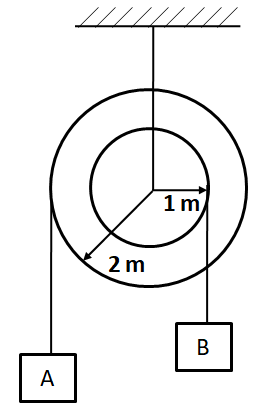
In the Pulley system shown, if the radii of the bigger and smaller pulley are $ 2m $ and $ 1m $ respectively, and the acceleration of the block A is $ 5m/{s^2} $ in the downward direction, the acceleration of block B will be:-

(A) $ 0m/{s^2} $
(B) $ 5m/{s^2} $
(C) $ 10m/{s^2} $
(D) $ \dfrac{5}{2}m/{s^2} $

Answer
557.7k+ views
Hint To solve this question, we need to use the concept of the constrained motion. We have to find the angular acceleration of the rotating pulley, with the help of which the velocity of block B will be obtained.
Formula Used: The formula used to solve this question is given by
$\Rightarrow a = \alpha r $ , where $ a $ is the linear acceleration, $ \alpha $ is the angular acceleration, and $ r $ is the radius.
Complete step by step answer
Let the acceleration of the block B be $ {a_2} $ .
We begin by finding the angular acceleration of the pulley. It is given that the block A, which is attached to the bigger pulley of radius $ 2m $ , has an acceleration of $ 5m/{s^2} $ . Since, the string connecting the block to the pulley is tangential with it, so we can say that this is the tangential acceleration of the block A, which is related to the angular acceleration of the bigger puller by
$\Rightarrow {a_1} = \alpha {r_1} $
According to the question, $ {r_2} = 2m $
$\Rightarrow 5 = 2\alpha $
Dividing by $ 2 $ we get
$\Rightarrow \alpha = \dfrac{5}{2}rad/{s^2} $ …………………….(1)
Now, since the smaller pulley of radius $ 1m $ is connected to the bigger pulley, so it will be constrained to rotate with the same angular acceleration of $ \alpha = \dfrac{5}{2}rad/{s^2} $ . So, the linear acceleration of the block B, which is connected through the string to the smaller pulley, is given by
$\Rightarrow {a_2} = \alpha {r_2} $
According to the question $ {r_1} = 1m $ . So we have
$\Rightarrow {a_2} = \alpha $
From (1) we finally get
$\Rightarrow {a_2} = \dfrac{5}{2}m/{s^2} $
Thus, the acceleration of block B is equal to $ \dfrac{5}{2}m/{s^2} $ .
Hence, the correct answer is option D.
Note
Do not try to use Newton's laws of motion to solve this question. In pulley problems, use of NLM is very common. But this is the problem of constrained motion, where we do not consider the forces acting on the system. So use of Newton’s laws will not work here.
Formula Used: The formula used to solve this question is given by
$\Rightarrow a = \alpha r $ , where $ a $ is the linear acceleration, $ \alpha $ is the angular acceleration, and $ r $ is the radius.
Complete step by step answer
Let the acceleration of the block B be $ {a_2} $ .
We begin by finding the angular acceleration of the pulley. It is given that the block A, which is attached to the bigger pulley of radius $ 2m $ , has an acceleration of $ 5m/{s^2} $ . Since, the string connecting the block to the pulley is tangential with it, so we can say that this is the tangential acceleration of the block A, which is related to the angular acceleration of the bigger puller by
$\Rightarrow {a_1} = \alpha {r_1} $
According to the question, $ {r_2} = 2m $
$\Rightarrow 5 = 2\alpha $
Dividing by $ 2 $ we get
$\Rightarrow \alpha = \dfrac{5}{2}rad/{s^2} $ …………………….(1)
Now, since the smaller pulley of radius $ 1m $ is connected to the bigger pulley, so it will be constrained to rotate with the same angular acceleration of $ \alpha = \dfrac{5}{2}rad/{s^2} $ . So, the linear acceleration of the block B, which is connected through the string to the smaller pulley, is given by
$\Rightarrow {a_2} = \alpha {r_2} $
According to the question $ {r_1} = 1m $ . So we have
$\Rightarrow {a_2} = \alpha $
From (1) we finally get
$\Rightarrow {a_2} = \dfrac{5}{2}m/{s^2} $
Thus, the acceleration of block B is equal to $ \dfrac{5}{2}m/{s^2} $ .
Hence, the correct answer is option D.
Note
Do not try to use Newton's laws of motion to solve this question. In pulley problems, use of NLM is very common. But this is the problem of constrained motion, where we do not consider the forces acting on the system. So use of Newton’s laws will not work here.
Recently Updated Pages
Why are manures considered better than fertilizers class 11 biology CBSE

Find the coordinates of the midpoint of the line segment class 11 maths CBSE

Distinguish between static friction limiting friction class 11 physics CBSE

The Chairman of the constituent Assembly was A Jawaharlal class 11 social science CBSE

The first National Commission on Labour NCL submitted class 11 social science CBSE

Number of all subshell of n + l 7 is A 4 B 5 C 6 D class 11 chemistry CBSE

Trending doubts
What is meant by exothermic and endothermic reactions class 11 chemistry CBSE

10 examples of friction in our daily life

One Metric ton is equal to kg A 10000 B 1000 C 100 class 11 physics CBSE

1 Quintal is equal to a 110 kg b 10 kg c 100kg d 1000 class 11 physics CBSE

Difference Between Prokaryotic Cells and Eukaryotic Cells

What are Quantum numbers Explain the quantum number class 11 chemistry CBSE




